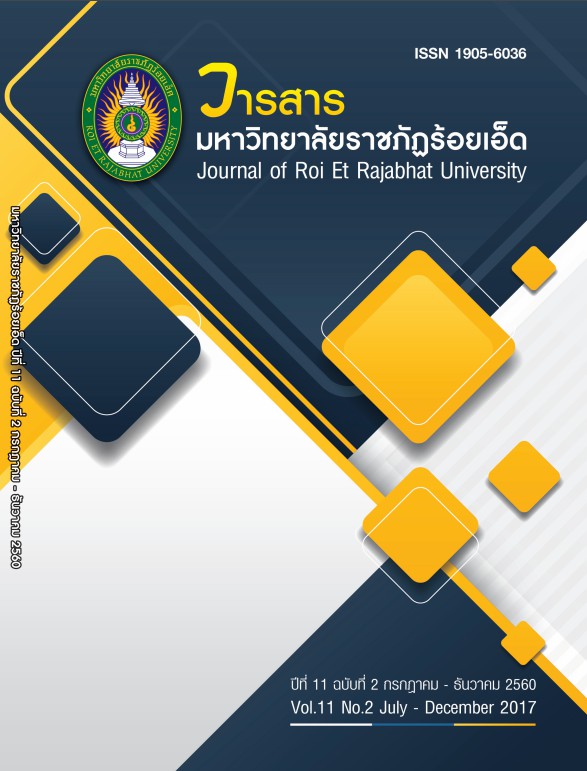ความสามารถในการถ่ายโอนความรู้เปรียบเทียบกับความสามารถในการแบ่งปันความรู้ และความสามารถในการสร้างความรู้ ในบริบทปรัชญาเศรษฐกิจพอเพียง : การศึกษา เชิงประจักษ์กลุ่มวิสาหกิจชุมชนในประเทศไทย
คำสำคัญ:
ความสามารถในการสร้างความรู้, ความสามารถในการถ่ายโอนความรู้, ความสามารถในการแบ่งปันความรู้บทคัดย่อ
ปัจจุบันธุรกิจมีการแข่งขันสูงและการดำเนินธุรกิจอยู่ภายใต้สภาวะแวดล้อมแบบพลวัต ดังนั้น ความสามารถในการ
ถ่ายโอนความรู้ และความสามารถในการแบ่งปันความรู้ จึงเป็นประเด็นสาคัญที่ทาให้ธุรกิจสามารถแข่งขันและเกิดความยั่งยืนได้
ภายใต้เงื่อนไขข้างต้นความสามารถในการถ่ายโอนความรู้ และความสามารถในการแบ่งปันความรู้เป็นองค์ประกอบหลักที่มี
อิทธิพลต่อความยั่งยืนทางธุรกิจ จากทฤษฎีมุมมองฐานความรู้และมุมมองฐานทรัพยากรอธิบายความสัมพันธ์ของกรอบแนวคิด
ซึ่งวัตถุประสงค์ของบทความนี้คือการนาเสนอความสัมพันธ์ระหว่างความสามารถในการถ่ายโอนความรู้เปรียบเทียบกับความสามารถ
ในการแบ่งปันความรู้ที่ส่งผลต่อความสามารถในการสร้างความรู้และความยั่งยืนทางธุรกิจ กรอบแนวคิดได้รับการทดสอบ
เชิงประจักษ์โดยใช้ข้อมูลที่ได้จากการสารวจผ่านทางไปรษณีย์ของกลุ่มวิสาหกิจชุมชนในประเทศไทย โดยผู้บริหารหรือผู้นำ
กลุ่มวิสาหกิจชุมชนของแต่ละกลุ่มเป็นผู้ให้ข้อมูลสาคัญ สถิติเชิงพรรณนา การวิเคราะห์ความสัมพันธ์และการวิเคราะห์การถดถอยพหุ
ถูกนำมาใช้เพื่อตรวจสอบและแสดงให้เห็นความสัมพันธ์ระหว่างตัวแปรต้นและตัวแปรตาม ซึ่งสมมติฐานที่ทดสอบมีทั้งหมด 5 ข้อ
ผลการวิจัยพบว่า ทั้งความสามารถในการถ่ายโอนความรู้และความสามารถในการแบ่งปันความรู้มีความสัมพันธ์เชิงบวกกับ
ความสามารถในการสร้างความรู้และความยั่งยืนทางธุรกิจ นอกจากนี้ได้อภิปรายถึงผลด้านทฤษฎีและการนาใช้ และข้อเสนอแนะ
สาหรับการวิจัยในอนาคต
เอกสารอ้างอิง
http://smce.doae.go.th
Agrawal, A. K. (2001). University-to-industry knowledge transfer: Literature review and
unanswered questions. International Journal of Management Reviews, 3(4), 285-302.
Argote, L., & Ingram, P. (2000). Knowledge transfer: a basis for competitive advantage in firms.
Organizational Behavior and Human Decision Processes, 1(82), 150-169.
Armstrong, S. J., & Overton, T. S. (1977). University-to-industry knowledge transfer: Literature
review and unanswered questions. Journal of Marketing Research, 3(14), 396-402.
Balogun, J., & Jenkins, M. (2003). Re-conceiving change management: A knowledge-based
perspective. European Management Journal, 2(21), 247-257.
Barney, J. (1984). Strategic factor markets: Expectations, luck, and business strategy.
Management Science, 10(32), 1231-1241.
Barney, J. (1991). Firm resources and sustained competitive advantage. Journal of
Management, 1(17), 99-120.
Brennenraedts, R., Bekkers, R., & Verspagen, B. (2006). The different channels of universityindustry
knowledge transfer : Empirical evidence from biomedical engineering.
Eindhoven: Technische Universiteit Eindhoven.
Garavelli, C. A., Gorgoglione, M., & Barbara, S. (2002). Managing knowledge transfer by
knowledge technologies. Technovation, 5(22), 269-279.
Hair, J., Black, W. C., Barbin, B. J., & Anderson, R. E. (2010). Multivariate data analysis. New
Jersey: Pearson Education International.
Hoskisson, R. E., Michael, H. A., William, W. P., & Daphne, Y. (1999). Theory and research in
strategic management: Swings of a pendulum. Journal of Management, 3(25), 417-
456.
Kogut, B., & Zander, U. (1993). Knowledge of the firm and the evolutionary theoy of the
multinational corporation. Journal of International Business Studies, 4(24), 625-645.
Krogh, G. V., Nonaka, I., & Rechsteiner, L. (2012). Leadership inorganizational knowledge
creation: a review and framework. Journal of Management Studies, 1(49), 240-277.
Le, C., & Fong, P. S. (2012). Revealing performance heterogeneity through knowledge
management maturity evaluation: A capabilities-based approach. Expert Systems with
Applications, 18(39), 13523-13539.
Nickerson, J., & Zenger, T. E. (2004). A Knowledge-Based Theory of the Firm. Organization
Science, 6(15), 617-632.
Piboolsravut, P. (2004). Sufficiency Economy. ASEAN Economic Bulletin, 1(24), 127-134.
Prahalad, C. K., & Hamel, G. (1990). The core competence of the corporation. Harvard
Business Review, May-June, 79-91.
Pulakos, E. D., Dorsey, D. W., & Borman, W. C. (2003). Hiring for knowledge-based competition.
San Francisco: JosseyBass.
Rouse, M. J., & Daellenbach, U. S. (2002). More thinking on research methods for the
resource-based perspective. Strategic Management Journal, 10(23), 963-967.
Smith, K. G., Collins, C. J., & Clark, K. D. (2005). Existing knowledge, knowledge creation
capability, and the rate of new product introduction in high-technology firms.
Academy of Management Journal, 2(48), 346-357.
Stevens, J. (2002). Applied multivariate statistics for the social sciences. New Jersey:
Lawence Erlbaum Associates.
Teece, D. J., Pisano, G., & Shuen, A. (1997). Dynamic capabilities and strategic management.
Strategic Management Journal, 7(18), 509-533.
Tsoukas, H. (1996). The firm as a distributed knowledge system: a constructionist approach.
Strategic Management Journal, 17(52), 11-25.
Wiklund, J., & Shepherd, D. (2003). Knowledge-based resources, entrepreneurial orientation,
and the performance of small and mediumm-sized businesses. Strategic
Management Journal, 13(24), 1307-1314.
Wright, P. M., & Scott, S. (2000). Toward a unifying framework for exploring fit and flexibility in
strategic human resource management. Academy of Management Review, 4(23), 756-772.
Yamane, T. (1973). Statistic: An introductory analysis. New York: Harper and Row.
Zollo, M., & Winter, S. G. (2002). Deliberate learning and the evolution of dynamic
capabilities. Organization Science, 13, 339-351.
Zuo, M. Y. (2003). Knowledge transfer in firm informatization. Chaina Managament
Informationization, 10, 10-11.
ดาวน์โหลด
เผยแพร่แล้ว
รูปแบบการอ้างอิง
ฉบับ
ประเภทบทความ
สัญญาอนุญาต
บทความที่ได้รับการตีพิมพ์เป็นลิขสิทธิ์ของวารสารมหาวิทยาลัยราชภัฎร้อยเอ็ด
ข้อความที่ปรากฏในบทความแต่ละเรื่องในวารสารวิชาการเล่มนี้เป็นความคิดเห็นส่วนตัวของผู้เขียนแต่ละท่านไม่เกี่ยวข้องกับมหาวิทยาลัยราชภัฎร้อยเอ็ด และคณาจารย์ท่านอื่นๆในมหาวิทยาลัยฯ แต่อย่างใด ความรับผิดชอบองค์ประกอบทั้งหมดของบทความแต่ละเรื่องเป็นของผู้เขียนแต่ละท่าน หากมีความผิดพลาดใดๆ ผู้เขียนแต่ละท่านจะรับผิดชอบบทความของตนเองแต่ผู้เดียว





